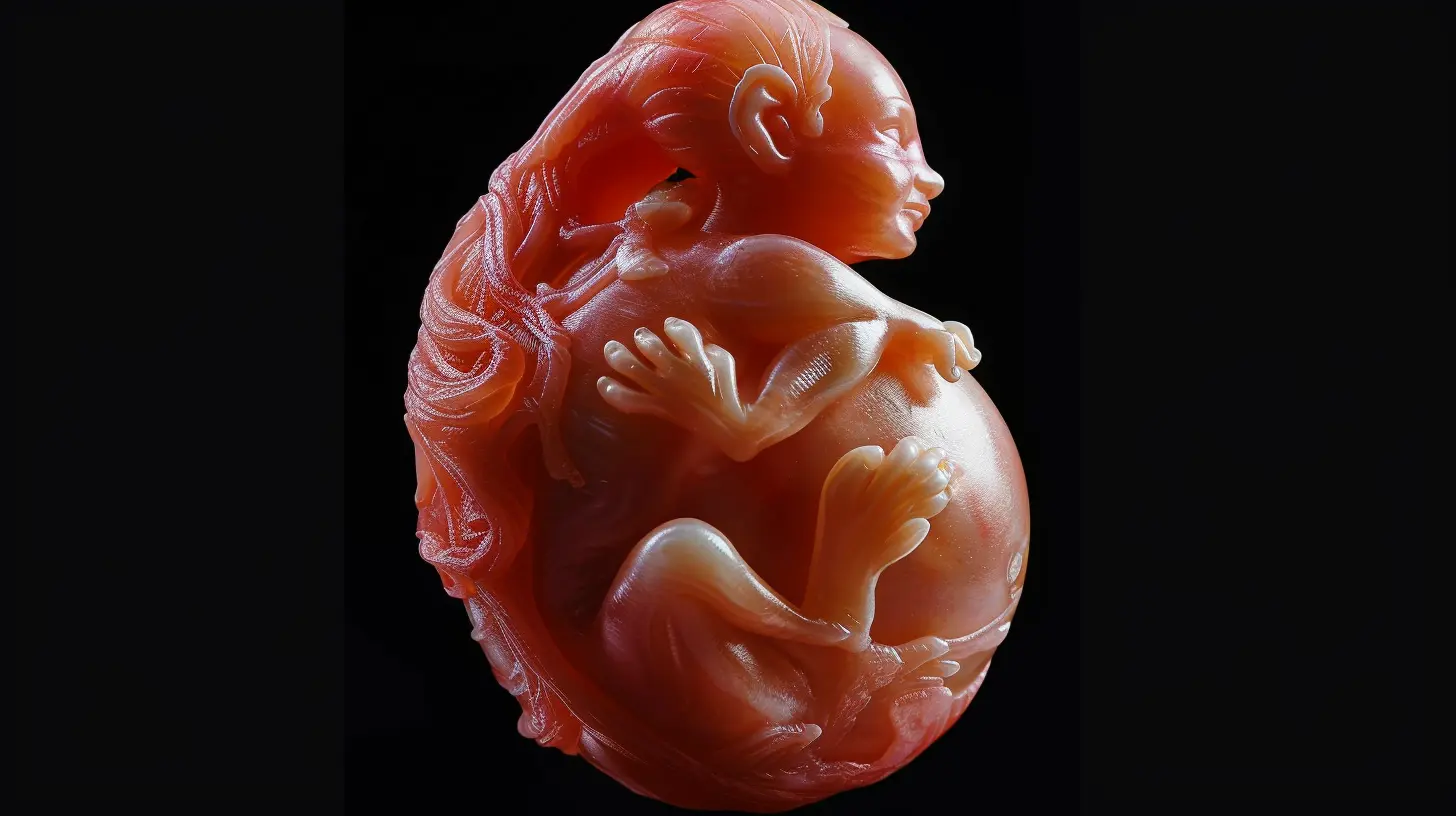Understanding Your Changing Body in the Second Trimester
9 January 2025
The second trimester of pregnancy is often referred to as the "honeymoon phase." Why? Because for many, it's a far cry from the rollercoaster of exhaustion and queasiness of the first trimester. Your energy levels might pick up, the morning sickness may ease, and you might feel more like yourself—albeit, a slightly rounder version. But let’s not sugarcoat it: there are still plenty of changes happening to your body during this phase.
If you’re wondering what’s going on behind the scenes (and what’s normal vs. what’s not), let’s break it all down step by step. This is your guide to understanding and embracing your changing body in the second trimester.
What Defines the Second Trimester?
Before we dive into the nitty-gritty, let’s define the timeline for the second trimester. It spans weeks 13 to 26 of your pregnancy. You’re past the early nerve-wracking stages where everything feels so new, and you’re not quite in the final stretch. Think of it as the middle lane of a highway—where the ride is often smoother, but you’re still on the journey.
Your Growing Belly: The Baby Bump is Here!
One of the most iconic changes during the second trimester is your growing baby bump. By week 13 or so, your uterus begins to expand upward, making that little bump much more noticeable. And trust me, people might start pointing it out with comments like, “Oh, look at you!” (whether you’re ready for it or not!)Why Is This Happening?
The growth is all thanks to your baby, who’s developing at super-speed. Did you know, by the end of the second trimester, your little one could weigh anywhere from 1 to 2 pounds and be about 13 inches long? That’s a whole lot of baby in there!Your abdominal muscles and skin stretch to accommodate this growth. As a result, you might notice some stretch marks—those red, purple, or silvery streaks. Don’t panic, though! These are super common and often fade with time. 
Hormones, Hormones, Hormones
Ah, hormones—the star players of pregnancy. If you thought they were done wreaking havoc after the first trimester, think again. During the second trimester, your body continues to produce hormones like progesterone and relaxin to help support your pregnancy.What Does That Mean for You?
Let’s break it down:- Glowing Skin: First, the good news. Those pregnancy hormones and increased blood flow might give you that famous pregnancy glow. Your skin could look radiant and plump, thanks to the extra oil production in your sebaceous glands.
- Skin Breakouts: On the flip side, all that oil production can lead to acne. It’s like being a teenager all over again! (But hey, it’s temporary.)
- Hair and Nail Growth: Your hair might start growing thicker and shinier, while your nails could grow faster than usual. It’s one of the perks that many moms-to-be rave about! 
Your Baby’s Movements: The Magic of the “Quickening”
This is one of the most exciting parts of the second trimester: feeling your baby move for the first time. This fluttery sensation, often called “quickening,” usually happens between weeks 16 and 22. At first, it might feel like tiny bubbles or soft flutters—almost like butterflies in your belly.Is It Normal Not to Feel Anything Yet?
Absolutely! Every pregnancy is different. Some women feel movement early on, while others might not notice it until closer to week 22. The position of your placenta can also play a role; if it’s located at the front of your uterus, it might cushion your baby’s movements, making them harder to detect.Changes in Your Breasts
Your breasts are also going through some noticeable changes—again, thanks to hormones. They might feel fuller, heavier, or even a bit sore. Around this time, colostrum (a yellowish pre-milk substance) might start leaking. It’s your body’s way of gearing up for breastfeeding.Nipples and Areolas
Your nipples and areolas may darken and become more prominent, as your body preps for its feeding role. Some women find this change fascinating; for others, it’s a bit unnerving. But rest assured, it’s completely normal.Round Ligament Pain: What You Need to Know
Ever felt a sudden sharp pain or pulling sensation on one or both sides of your lower belly? That’s your round ligaments stretching. These ligaments support your growing uterus, and during the second trimester, they’re working overtime to keep up with your expanding bump.Tips for Easing Discomfort
- Move Slowly: Quick movements or sudden changes in position can trigger this pain, so take things slow.- Stretch: Gentle stretching exercises or prenatal yoga can help ease tension.
- Support: Wearing a belly band can provide extra support and alleviate some of the strain.
Increased Appetite: Eating for Two
By the second trimester, your appetite might come roaring back with a vengeance. After weeks of nibbling on crackers in the first trimester, you could suddenly feel like you can eat an entire pizza by yourself (and still have room for dessert).What Should You Be Eating?
It’s not about eating double the portions but doubling up on nutrient-rich foods. Focus on whole grains, lean proteins, fruits, veggies, and healthy fats. And don’t forget those prenatal vitamins—they’re your nutritional safety net.Common Discomforts During the Second Trimester
Let’s be real: even during this “easier” phase of pregnancy, it’s not all sunshine and rainbows. Here are a few discomforts you might face and how to tackle them:1. Heartburn
As your uterus grows, it pushes up on your stomach, which can cause stomach acid to creep into your esophagus. (Hello, burning sensation!)Tips: Try eating smaller meals, avoid spicy or greasy foods, and sleep slightly elevated.
2. Back Pain
Your growing belly shifts your center of gravity, which can strain your back.Tips: Practice good posture, wear supportive shoes, and consider prenatal massage.
3. Leg Cramps
These often strike at night and can be a real pain—literally.Tips: Stay hydrated, stretch your calves before bed, and make sure you’re getting enough magnesium and calcium.
Mental and Emotional Changes
It’s not just your body going through changes—your mind is along for the ride, too. You might feel calmer and more connected to your pregnancy during this phase, but it’s also normal to have moments of anxiety or mood swings.How Can You Cope?
- Talk About It: Share your feelings with your partner, a friend, or a support group. You’re not alone in this!- Self-Care: Take time for yourself, whether it’s a relaxing bath, a good book, or a prenatal yoga class.
- Prepare for Baby: Use this trimester to start planning for your little one’s arrival. Shopping for baby gear can be exciting and help you feel more prepared.
When Should You Call Your Doctor?
While most second-trimester changes are harmless and normal, there are a few red flags to watch for.- Severe or constant abdominal pain
- Heavy bleeding or spotting
- Severe headaches or vision changes
- Sudden swelling in your hands, face, or feet
- Decreased fetal movement after 24 weeks
Don’t hesitate to reach out to your healthcare provider if something feels off. Better safe than sorry!
Embrace the Changes
The second trimester is a whirlwind of growth, change, and preparation—both for you and your baby. Yes, there are challenges, but there’s also magic in the journey. From feeling those first kicks to watching your body do incredible things, this phase is one to cherish.Remember, every pregnancy is unique, so don’t compare yourself to others. Embrace the changes, listen to your body, and above all, enjoy this special time.
all images in this post were generated using AI tools
Category:
Pregnancy HealthAuthor:

Laura Hudson
Discussion
rate this article
13 comments
Jinx Kirk
Ah, the second trimester—when your body suddenly decides to audition for a science fiction film! Who knew growing a tiny human would come with unexpected side effects like cravings that rival a toddler's snack time and a belly that could double as a table? Just remember, it’s all part of the magical mystery tour!
February 9, 2025 at 3:59 PM

Laura Hudson
Absolutely! The second trimester is indeed a wild ride filled with surprising changes and cravings. Embrace the journey—it's all part of the miracle of pregnancy!
Liam Cummings
Great insights! This is incredibly helpful for expecting mothers.
January 31, 2025 at 4:07 PM

Laura Hudson
Thank you! I'm glad you found it helpful. Wishing all expecting mothers a smooth journey!
Bethany Holland
This article offers such valuable insights into the second trimester! It’s fascinating how our bodies evolve during pregnancy. I’m eager to learn more about the changes and their impacts!
January 27, 2025 at 6:15 PM

Laura Hudson
Thank you! I'm glad you found the insights valuable. The second trimester is indeed a fascinating time of change. Stay tuned for more information!
Zane McGarvey
Embrace the transformative journey of your second trimester; understanding your changing body empowers you to celebrate this incredible experience.
January 23, 2025 at 5:32 PM

Laura Hudson
Thank you for your thoughtful comment! Embracing this transformative journey truly enhances the experience.
Genevieve Newton
The second trimester brings significant physical changes. It's essential to understand these transformations to manage discomfort and promote a healthy pregnancy for both mother and baby.
January 20, 2025 at 5:21 PM

Laura Hudson
Absolutely! Understanding these changes is crucial for a smoother pregnancy experience. Your body is doing amazing things, and being informed can help you navigate any discomfort effectively.
Onyx McLoughlin
This article beautifully captures the journey of the second trimester. Embrace the changes—your body is doing something amazing!
January 18, 2025 at 5:05 PM

Laura Hudson
Thank you! I'm glad you enjoyed the article and appreciate the beauty of this transformative journey.
Maxine Castillo
The second trimester brings significant hormonal changes, body adjustments, and growth; understanding these shifts is vital for expectant mothers' well-being.
January 17, 2025 at 5:10 AM

Laura Hudson
Absolutely! Recognizing these changes is essential for navigating the second trimester and promoting both maternal and fetal health.
Sofia McVicker
Embrace the bloom within.
January 15, 2025 at 3:46 PM

Laura Hudson
Thank you! Embracing the changes is essential for a positive journey during this time.
Grayson Mendoza
This article beautifully captures the remarkable changes happening during the second trimester. Embrace this journey with self-compassion and curiosity. Remember, each change brings you closer to welcoming your little one. Trust your body's wisdom, and take time to celebrate this incredible transformation. You've got this!
January 15, 2025 at 4:54 AM

Laura Hudson
Thank you for your kind words! Embracing this journey with self-compassion is truly important. We're all in this together!
Heather McDougal
The second trimester is a transformative phase where many women experience increased energy and physical changes. Understanding these shifts fosters body positivity and prepares for the upcoming challenges. Embrace this journey by prioritizing self-care, staying active, and seeking supportive resources to navigate this exciting chapter.
January 13, 2025 at 5:15 AM

Laura Hudson
Thank you for highlighting the importance of embracing the changes in the second trimester! Prioritizing self-care and staying active are indeed key to navigating this transformative phase positively.
Zorina Mendez
Thank you for sharing this insightful article! The second trimester is such an important time of change, and your guidance makes it feel less overwhelming. It’s reassuring to know we’re not alone in navigating these transformations. Looking forward to more valuable tips on this journey!
January 12, 2025 at 5:11 PM

Laura Hudson
Thank you so much for your kind words! I'm glad you found the article helpful. Stay tuned for more tips as you continue your journey!
Rose McCaw
This article beautifully captures the journey of the second trimester! It’s an exciting time filled with changes, and understanding them is key to embracing this experience. Remember, it's completely normal to feel a mix of emotions. Trust your body and enjoy each moment—you're doing an amazing job! 🌟
January 11, 2025 at 5:12 AM

Laura Hudson
Thank you for your kind words! I’m glad you found the article helpful in navigating this exciting time. Embracing those changes is so important! 🌼
Zailyn Duke
Congrats on the glow-up! Embrace those curves—your body's just leveling up to create a tiny human. Own it, queen!
January 9, 2025 at 6:06 PM

Laura Hudson
Thank you so much! Embracing these changes has been an empowering journey. 🌟
MORE POSTS

Boost Your Mood Naturally with These Superfoods

Fueling Your Workout with Vegan Pre- and Post-Workout Meals

Explosive Power: Plyometrics and Their Role in Bodybuilding

Elevating Your Energy Levels with Natural Remedies

Bone-Boosting Smoothie Recipes You’ll Love

The Art of Saying No: Establishing Healthy Boundaries

Yoga Poses for Building Better Bones

Training Like a Pro: How to Approach Split Routines

Why Berries Are Some of the Most Potent Superfoods